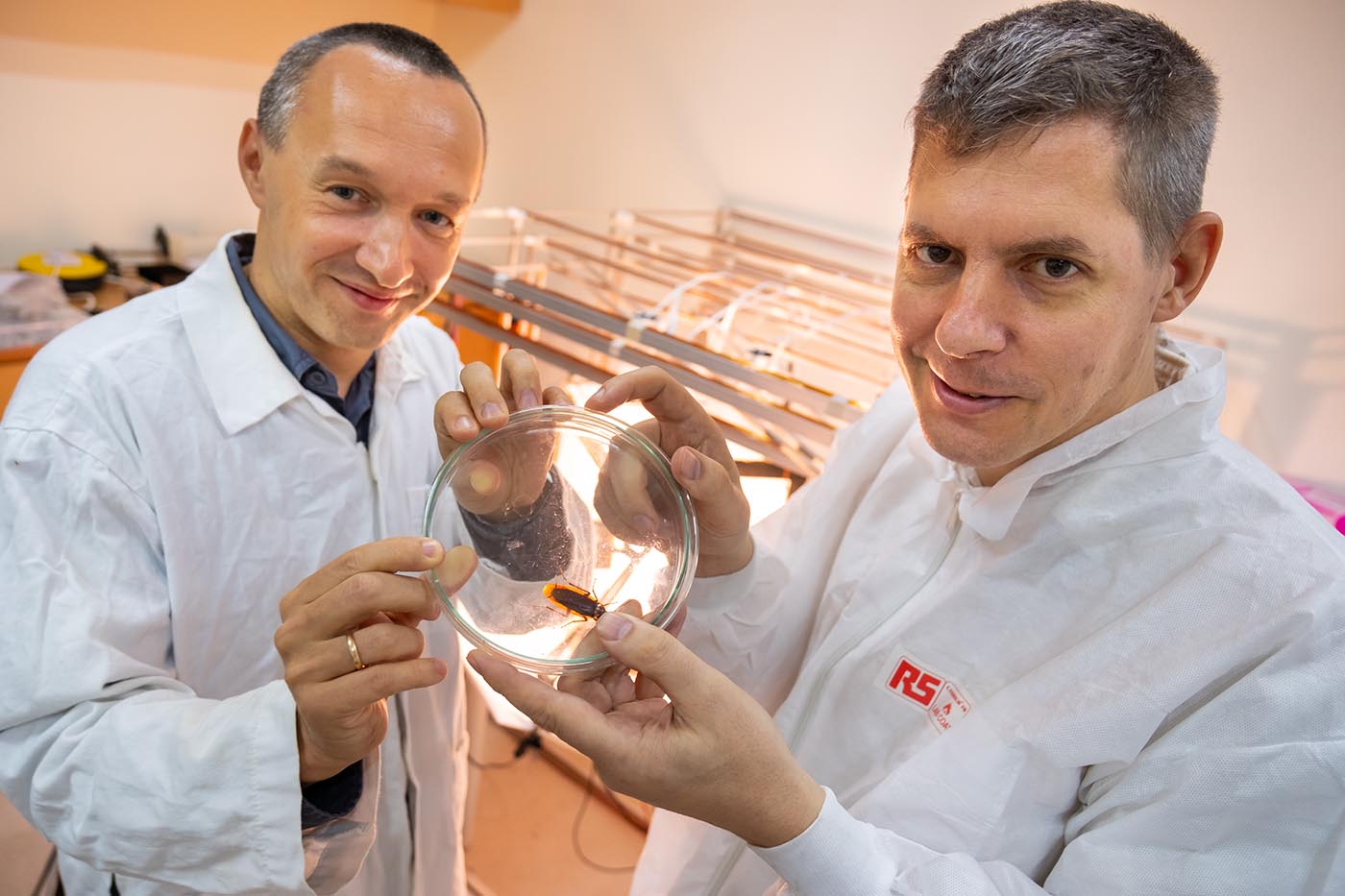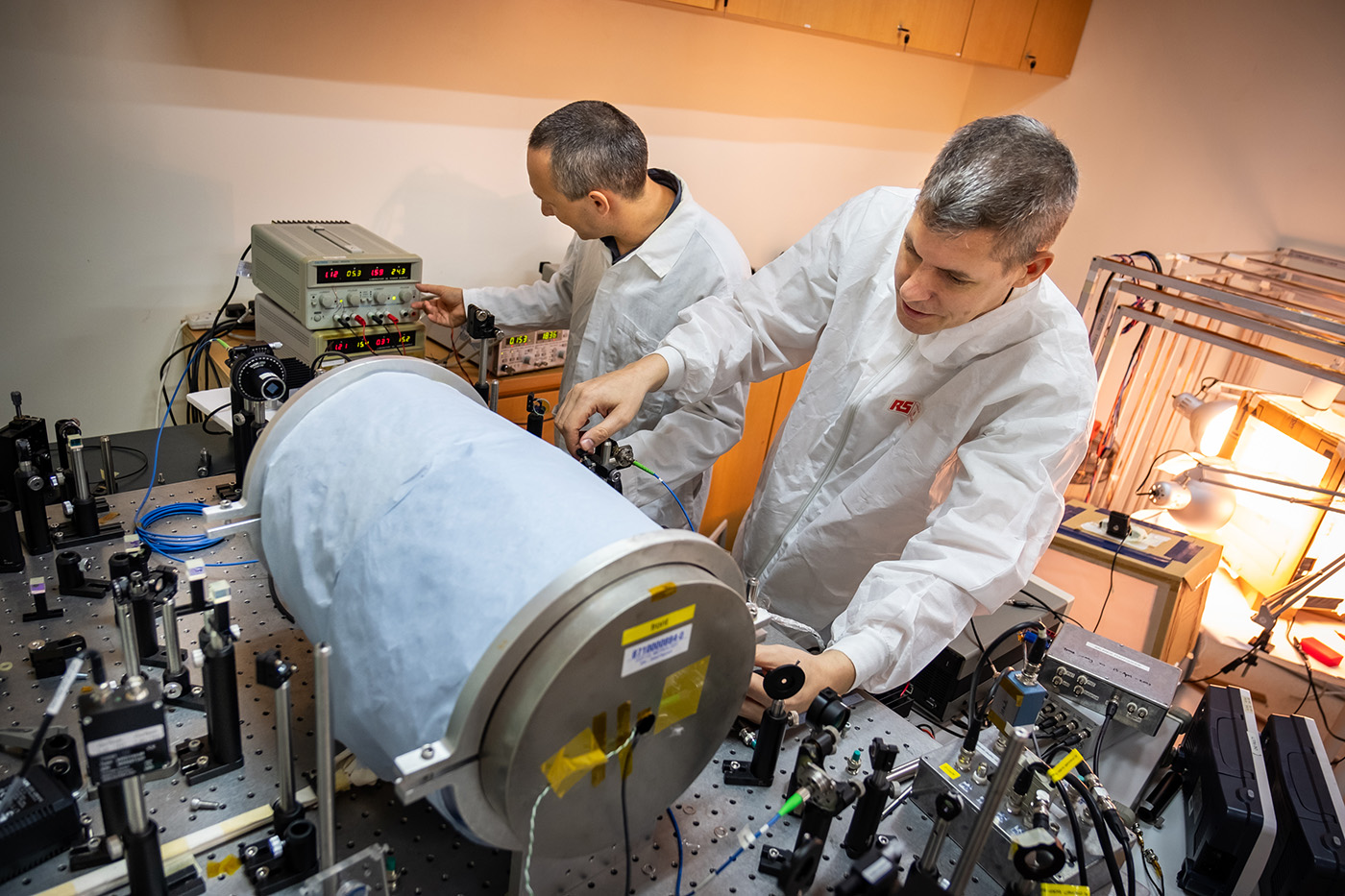Highlights
Cockroaches win award for quantum researchers
 Rainer Dumke (right) and Tomasz Paterek (left) investigated the magnetic properties of the American cockroach (Periplaneta Americana). Image Credit: NTU Singapore
Rainer Dumke (right) and Tomasz Paterek (left) investigated the magnetic properties of the American cockroach (Periplaneta Americana). Image Credit: NTU Singapore
The application of an advanced quantum technology to cockroaches has won an international team of researchers an Ig Nobel Prize. CQT Principal Investigator Rainer Dumke is among the winners announced on 12 September.
The Ig Nobel Prizes, a satirical counterpart to the Nobel prizes, have been presented annually since 1991. They are intended to “celebrate the unusual, honor the imaginative — and spur people’s interest in science, medicine, and technology”.
The award was presented for the paper “In-vivo biomagnetic characterisation of the American cockroach", published in Scientific Reports in March 2018 by Rainer and five collaborators. The work had already drawn attention: MIT Technology Review and Physics World reported on the findings in 2017 when the results first appeared in a preprint.
Rainer and corresponding author Tomasz Paterek, who are faculty at the Nanyang Technological University, Singapore (NTU Singapore), received their award in a ceremony at Harvard University in the United States. They received the 2019 Ig Nobel Biology Prize.
Precision measurement
For their prize-winning research, the team used an ‘atomic magnetometer’ to measure the magnetic properties of cockroaches. The magnetometer is a high-precision quantum device, capable of measuring magnetic fields ten billion times weaker than Earth’s magnetic field.
Rainer’s team had earlier built the magnetometer to an innovative design described in a 2015 paper. It detects magnetic fields by looking for changes in the way a laser beam interacts with a gas. Such devices may be useful in searching for mineral deposits, detecting buried objects and biological imaging.
 Rainer and Tomasz working with their atomic magnetometer at NTU Singapore. Image Credit: NTU Singapore
Rainer and Tomasz working with their atomic magnetometer at NTU Singapore. Image Credit: NTU Singapore
But why measure roaches? The team’s goal was to investigate how cockroaches may be able to sense magnetic fields. As well as providing new information about the bugs’ biology, such research could point to designs for biologically-inspired sensors.
Experiments by other researchers have shown that cockroaches respond to magnetic fields, with one possibility being that cockroaches use tiny magnetic particles in their bodies like miniature compasses. Cockroaches are not well known for their animal magnetism, but magnetic sensory powers are known to exist in some creatures. Birds, for example, can see Earth’s magnetic fields.
“Our interdisciplinary research blends both fields of entomology and physics, to resolve important magneto-reception questions using an unconventional medium – that is, the humble cockroach,” says Tomasz.
Animal magnetism
The researchers did their experiments at the School of Physical and Mathematical Sciences at NTU Singapore. They exposed cockroaches to a strong magnetic field for about 20 minutes. Next, they put each insect inside the magnetometer, in an origami box, to measure how strongly it had become magnetised and how quickly the magnetisation decayed. They did this for both living and dead cockroaches.
The researchers observed that the magnetic field of the living cockroaches decayed in about 50 minutes while it took almost 50 hours to decay in dead cockroaches. They suppose the decay slows because fluids inside the cockroach harden after death. The Ig Nobel organisers officially cited the researchers for "discovering that dead magnetized cockroaches behave differently than living magnetized cockroaches". (Watch the ceremony online here - the biology prize is presented at minute 51.)
From the data, the team built a model of how magnetic particles in the cockroaches’ bodies behave. They conclude that such particles cannot be responsible for cockroaches’ ability to sense magnetic fields.
“It was a common belief that some insects have a form of magnetised navigation mechanism. Our research now substantiates the claim that cockroaches might have another form of magneto-reception mechanism, opening the door for further studies on insect navigation and even bio-sensor applications,” said Rainer.
Surprise applications
“Whenever scientists come up with new technology, that technology is likely to find applications we could never have predicted at the outset of the research. Using an atomic magnetometer to study the magnetism of cockroaches is an excellent example of an unexpected use case for a quantum device. The findings also fit the ambition of Ig Nobel Prizes to honour achievements that make you laugh, then think,” said CQT Director Artur Ekert.
In winning the Ig Nobel award, cockroaches follow in the footsteps of other critters. The 2017 physics prize, for example, went to research on whether cats behave like fluids, the 2015 biology prize was won by a team which gave chickens artificial tails to make them walk like dinosaurs, and the 2000 physics prize was awarded to researchers who used magnets to levitate a frog. Physicist Andre Geim who shared the prize for frog levitation went on to win the Nobel Prize in physics (for unrelated work) in 2010 – the only individual, so far, to have won both accolades.






